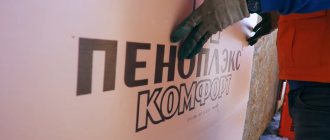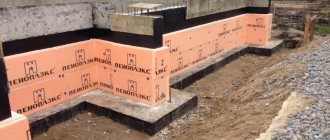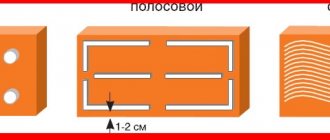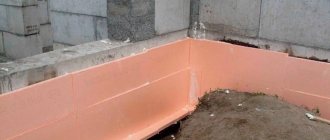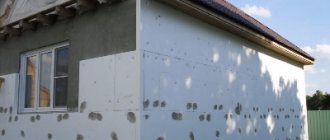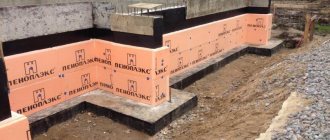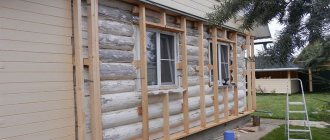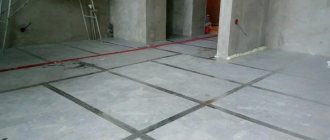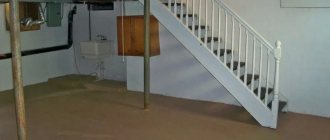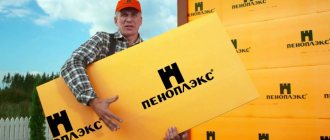There is a strong opinion that it is better to insulate a wooden house from the outside: heat loss is minimal, the service life of the building is increased, the interior space of the rooms is saved, and the dew point moves outward. Recently, penoplex is often used for external insulation (people write and say penoplex), but some of its properties have an adverse effect on the microclimate of the house. Let's find out whether it is possible to insulate a wooden house with penoplex from the outside or not.
Installation of penoplex in frame house construction is carried out using glue and disc fasteners with self-tapping screws
When is insulation of wooden houses required?
Wood is a building material that retains heat with good thermal conductivity. If the construction technology of a log house is violated, living in it becomes less comfortable.
There are several reasons for heat loss in a wooden house:
- insufficient thickness of lumber;
- incorrect choice of method for angular connection of parts;
- insufficient sealing of windows and discrepancy between the number of cameras and the climatic conditions in the region;
- gaps between the crowns that appeared as a result of shrinkage of the log house;
- blowing due to old caulk.
Foundation insulation
Using penoplex you can also perform thermal insulation of the foundation of a wooden house. In this case, the slabs should be installed from the inside to prevent the formation of condensation on the inner surface of the wall.
Thermal insulation of the foundation also allows you to create an optimal basement microclimate. In addition, the room will become much warmer and heating costs will be reduced.
Video to help:
Additionally, you can make thermal insulation of the floor in a wooden house.
Penoplex occupies one of the leading positions among modern insulation materials. It is used in both industrial and private construction, due to its excellent performance characteristics. The material also shows good results when used in wooden houses. Today, the question practically no longer arises whether it is possible to insulate a wooden house with penoplex, since most owners of log buildings have already tested this insulation in practice and were very satisfied. In the article we will analyze in detail the characteristics of the material, and also dwell on its types. In addition, you will learn how to properly perform thermal insulation with penoplex yourself.
Requirements for the thermal insulation circuit
To prevent the formation of cold bridges in the house, it is important to create a heat-insulating circuit between the environment and living spaces.
If the wall is not insulated, the dew point is inside the wall and creates moisture. It is necessary to use insulation to shift the dew point outward, to the surface of the insulation
A continuous circuit made of material with low thermal conductivity will prevent cold air from entering the home and prevent heat from escaping outside.
There are certain requirements for the heat-insulating circuit. He must:
- be breathable. Wood can breathe. It has high vapor permeability and regulates the natural microclimate in the house. The insulation on the outside must also allow air to pass through and at the same time be moisture resistant. Air circulation prevents the accumulation of moisture in the wood and on its surface, prevents the formation of condensation and the appearance of mold in it;
- have low thermal conductivity, keeping the house warm;
- have low flammability to prevent the wood from igniting. Flammability is the property of a material to resist the effects of fire;
- weigh little so as not to place a significant load on the structure.
Is penoplex suitable for insulating a wooden house from the outside?
To insulate the outside of a wooden house, it has long been lined with brick. But new modern materials have appeared that effectively retain heat in the house. Such materials include penoplex. It is foamed polystyrene, produced in production by exposing it to high temperature and pressure. When the pressure is released, the mass begins to expand, forming foam.
Penoplex structure
When the temperature drops, it begins to harden. It is passed through extruders. The result is a material in which most of the components are saturated with air. Closed cells measuring 0.1-0.2 mm do not allow moisture and steam to pass through. To find out whether penoplex is suitable for insulating a wooden house from the outside, let us draw your attention to its features and whether they meet the requirements for a heat-insulating circuit. To do this, we will determine the pros and cons of such thermal insulation.
How to distinguish
You can distinguish polystyrene foam from penoplex by appearance. The first material is produced in the form of a lightweight slab, on the surface of which foam balls filled with oxygen are visible. The sheets of the second raw material are dense in structure, somewhat similar to polymerized construction foam.
Color is a noticeable difference between penoplex and expanded polystyrene. On the cut of the slab of the first material, orange or yellowish tones are visible. Insulation made from foam balls is always produced in a snow-white palette.
White and colored insulation Source zen.yandex.ru
You can distinguish raw materials by price. The cost of polystyrene foam is 1.5-2 times lower than that of penoplex. The first material has worse thermal insulation parameters than the second. To get equally effective insulation, you need to purchase more blocks of foam balls.
Manufacturers produce the material in sheets, the thickness of which varies from 20 to 100 mm. Given the same dimensions, the foam block will be 50% lighter than the extruder model. Penoplex is afraid of ultraviolet radiation, so the material is protected with shrink film. Polystyrene foam is sold in regular plastic packaging.
Knowing the differences between penoplex and expanded polystyrene, it is easy to choose insulation yourself. Both materials can be cut with a construction knife. When working with the first, the user presses lightly on the blade and easily divides the sheet. The second raw material is susceptible to crumbling, so with careless movements the block breaks and crumbles into small balls.
Particles of cheap material Source superdom.ua
Advantages and disadvantages of such thermal insulation
Let's figure out what the advantages and disadvantages of external insulation with penoplex are.
- An important aspect of the popularity of extruded polystyrene foam for external insulation is its affordable price. The cost of the entire heat-insulating circuit around the house is quite acceptable for any category of citizens.
- Penoplex has a low thermal conductivity of 0.029-0.034, thanks to which heat is retained indoors.
- It is wear-resistant. Does not change its original properties over a long period of time with significant temperature changes and can withstand up to 1000 freezing and thawing cycles. At the same time, thermal insulation performance remains at the same level.
- Penoplex is impact resistant. Withstands any mechanical stress, does not deform and retains its shape from compression and stretching.
- Extruded polystyrene foam is lightweight. The insignificant mass of the material does not put pressure on the walls or foundation, so it can be used in buildings that are not strong enough.
- Easy and simple installation helps save money on calling a specialist. You can insulate the walls yourself without the help of helpers or professional craftsmen. The need for tools is minimal.
- The service life of extruded polystyrene foam, guaranteed by the manufacturer, is 50 years.
- Penoplex is characterized by low moisture absorption: up to 0.5%
- The advantage of extruded polystyrene foam is its bioresistance to various chemicals: acids, alkalis, vegetable oils.
- The range of foamed polystyrene boards is varied in type, density, thickness and thermal conductivity.
Penoplex is most preferably used when insulating frame buildings, always using a vapor barrier film inside the building or when insulating temporary buildings (houses, garages, etc.)
But at the same time, insulating penoplex from the outside has a number of disadvantages:
- it is vapor-tight. Not only water, but also steam and air do not pass through the closed pores of extruded polystyrene foam. Penoplex, enclosing the house on all sides, will prevent the passage of air inside, the tree will stop breathing. As a result, condensation forms on the inner surface of the wall;
- has a high flammability group. Being near flammable material (wood) may cause a fire. When burning, it releases toxic, caustic substances;
- cannot tolerate exposure to ultraviolet rays. From their direct influence it begins to crumble and collapse. To prevent its destruction, the insulation is covered with finishing materials;
- low frost resistance leads to the appearance of cracks in the material.
Penoplex - what kind of material is it and its features
Penoplex, or as it is called extruded polystyrene foam, is a high-quality and effective insulation material. It is made using special technology. The result is an airy, light and durable material that comes in a variety of thicknesses. As for the characteristics, the following should be noted.
- Thermal conductivity. Here the figures turned out to be quite low, only 0.03 W/m-K. Even operating conditions do not affect the change in this parameter. Accordingly, this material is used for any insulation work.
- Water absorption. It also has a very low rate, regardless of how much liquid is poured onto the material. However, if moisture penetrates the insulation boards, it will remain strictly in the upper layers.
- Environmental friendliness. The material is considered absolutely safe for all operating conditions, since it does not contain harmful resins or toxic odors that can affect human health. This characteristic is confirmed by the relevant standards.
- Vapor permeability. This characteristic corresponds to the minimum values, since the material is not capable of passing through either hot or cold vapors. Accordingly, condensation in the layers of polystyrene foam slabs will not accumulate, and the wood will not become a victim of fungal attack.
- Chemical resistance. It is known that penoplex is capable of contact with many different substances that are used for construction. This can be alcohol-based or water-based paint. Compatible with concrete mixtures and oils.
- Strength. The state of compressive strength is quite high due to the extrusion process that is used to create the material. However, this raw material is very sensitive to mechanical stress.
The high degree of flammability, which corresponds to class G4, must also be taken into account. This indicates that the material should be used with caution in environments near open flames.
The use of penoplex for insulating a house made of solid wood Source odstroy.ru
On a note! Penoplex is able to perform its function in the temperature range -50-+75 degrees. But when the specified upper maximum is exceeded, the material begins to release harmful substances.
Types of penoplex
To insulate a wooden house, the following types of penoplex are used:
- slabs for vertical structures. They are designed to insulate walls and partitions inside and outside the house. The insulating material has a density of 22 kg/m3. The milled surface of this type of penoplex improves adhesion to various mixtures: adhesive and plaster compositions;
- "Comfort" series. This is a universal insulation material, which, due to its positive properties: strength, low thermal conductivity and moisture resistance, is successfully used to insulate ceilings, walls, plinths, foundations, and walls. It is able to withstand high humidity, so it is widely used as a heat insulator for bathrooms, baths and saunas. The density is the same as the previous type;
- heat insulator for roofing. It has a high density: from 26 to 34 kg/m3. Successfully used for pitched roofs. The slabs have a U-shaped edge, due to which the joints between the sheets are almost invisible. The insulation forms a flat surface on which any roofing materials can be laid;
- insulation for the foundation. It has a high density of 27-35 kg/m3. Durable, withstands significant loads. Insulated structures—foundation, but also floors, basement.
Foam cutting
The industry produces sheets of foam plastic with a thickness of 20-500 mm in increments of 10 mm, less often in increments of 5 mm. Standard sizes of polystyrene foam for wall insulation:
- sheet length 100 and 200 cm;
- width from 50 to 200 cm.
Note! To perform high-quality foam insulation of a frame house, you need to carefully choose the thickness of the material!
To cut sheets of the required thickness and length, you can use several methods:
- by using a simple stationery knife;
- by using a nichrome spiral.
The first method is the most accessible and requires virtually no skills. It consists of the following:
- Use a pencil or marker to mark the edges of the cut;
- connect the points using a metal ruler, getting a straight line;
- Without removing the ruler, take a knife and draw along the line, and it is not necessary to completely cut through the foam;
- repeat the operation on the reverse side of the sheet;
- break off the material along the cut line.
The second method allows for a smoother cut, but requires some preparation and the availability of certain materials and devices. To make a cutter you will need nichrome wire, a step-down transformer, an insulator holder, etc.
How to comply in practice
To properly insulate a wooden house from the outside, you need to take into account several nuances.
If a frame house is to be thermally insulated, it is important that the wood is well dried in special chambers, otherwise damp wood can lead to the formation of mold.
Let's see if there is ventilation in the timber structure. Air does not pass through foamed polystyrene boards because penoplex has low vapor permeability. Water vapor tends to escape through the joints between the slabs, which are covered with polyurethane foam. Vapors pass through it, accumulating condensate in these areas. Every day the amount of accumulated moisture increases. Insulated walls become covered with fungus.
To prevent the formation of condensation in a wooden house, you need to ensure good ventilation. Fanned walls and insulation will remove excess moisture. Optimal ventilation can be ensured by creating a ventilation gap between the wooden wall and the thermal insulation. But in this case, creating a gap between the wall and extruded polystyrene foam is prohibited, because wood is a flammable material, and in the vicinity of extruded polystyrene foam the risk of fire increases.
If you eliminate the gap between the penoplex and the wall and tightly glue the insulation to it, then after a while black mold will form under the thermal insulation, a damp smell will appear, and the wooden house may begin to collapse. In addition, it is impossible to ensure a tight fit of the material to the logs due to the structural features of the crowns.
Recommendations for laying thermal insulation
In most cases, external insulation is practiced in private houses, which, when carried out correctly and with accurate calculations, provides effective thermal protection of the entire structure. External thermal insulation allows you to move the dew point towards the insulation, and thereby protect the walls from the formation of condensation.
In addition, penoplex has low vapor permeability, which is why it is not recommended for use inside the house. Negative consequences can be mitigated by installing a high-quality ventilation system.
Thermal insulation of walls outside and inside the house
The insulation is attached to the walls of the log house using adhesive or frame methods. It should be taken into account that due to its high density, penoplex does not absorb the adhesive solution well enough.
Over time, the fastening weakens, as a result of which the slabs and finishing sheathing can settle, which will lead to the formation of cold bridges and loss of appearance. The same thing can happen with the frame finishing option.
Therefore, many people have a question: how to attach penoplex to a vertical surface? Experts say that you cannot limit yourself to just gluing or laying insulation into the cells of the frame. In both cases, it is also necessary to secure the heat insulator with special mushroom fasteners with wide lids.
In frame houses, penoplex is placed inside the frame, where it is glued and additionally secured with dowels.
Insulating a log house from the outside can be done in both ways. For thermal insulation of a house made of 150x150 timber and internal structures, it is better to choose a frame option. There should be a small space between the insulation and the walls of the house, in this case the air will circulate freely and prevent the wood from moistening.
Scheme of insulation of external walls of a house
Due to the roundness of the logs, log walls have gaps where air can penetrate; the surface of a log house is flat, which makes natural ventilation impossible.
For the sheathing, timber with a cross section of 25x50 or 50x50 mm is used. The installation of the frame must be done in such a way that it forms squares, into which the insulation boards will then be laid.
To give greater rigidity to the insulated structure and prevent cold from entering the house, it is better to lay penoplex in two layers. Sheets are installed offset or in perpendicular directions. In the second case, a counter-lattice is made to lay the top layer; the slats are positioned perpendicular to the guides of the main frame.
The façade insulation scheme for siding is as follows:
- vapor barrier film;
- wooden sheathing;
- thermal insulation;
- hydro-windproof film;
- finishing material.
When insulating inside the house, the same scheme is used, but the waterproofing will be located between the wall and the insulation, and the vapor barrier should be under the decorative cladding.
Foundation insulation
- To improve the adhesion of the base to the adhesive composition, it is necessary to carefully prepare the insulated surface: clean it of debris, dust, and contaminants. The best way to do this is with a grinder.
- A thick layer of bitumen waterproofing mastic is applied to the prepared base.
- The roofing material is glued, first the lower part of the foundation is glued, then the upper. The strips of material should overlap each other on a horizontal surface by 10 cm, at the corners of the house by 15 cm. For reliability, it is recommended to cover the foundation with another continuous layer of roofing felt.
- Penoplex boards are glued onto the waterproofing. To do this, you should use either water-based bitumen mastic or an adhesive composition specifically designed for working with polystyrene foam. The glue is applied to the slabs in 5-6 places pointwise; when gluing, it should cover at least 40% of the surface area.
- Installation of insulation begins from the bottom, the sheets are pressed tightly against the surface and the adjacent panel, and it is necessary to combine the tongue-and-groove joints. Plates located above ground level are additionally fixed with mushroom dowels.
How to insulate a wooden floor
Thermal insulation of a wooden floor with penoplex is usually carried out along the joists. Warming is carried out in the following order:
- Installation of rough ceiling.
- Laying a waterproofing layer.
- Installation of foam boards.
- Fixing the insulation with self-tapping screws.
- Filling gaps between slabs with foam.
- Laying vapor barrier film.
- Laying the finished floor on beams.
- Installation of finishing coating.
The technology for insulating the floor in a wooden house from below along joists, as well as the rules for installing insulation under a concrete base, are described in more detail in the article “How to properly insulate the floor from below - rules and nuances.”
Penoplex is different in that it can be laid directly on open, dry and well-compacted soil. This insulation option is usually used under a concrete screed.
In this case, the following installation scheme is used:
- A 30 cm layer of compacted crushed stone is laid below.
- Next comes a layer of sand, compacted to a thickness of 10 cm.
- Then lay penoplex 100 mm thick (thinner sheets can be laid in two layers perpendicular to each other). The plates are glued together with special metallized tape.
- Next, a waterproof film is laid.
- A fiberglass mesh is laid on top.
- A 5 cm thick screed is poured on top.
Risks when insulating with penoplex
To prevent the appearance of mold when gluing penoplex in a frame and timber structure, it is necessary to create powerful supply and exhaust ventilation, which will negatively affect the heating system in terms of costs. Only an expensive ventilation system based on heating cold air from the street with warm air from inside the house will save you. Then cheap penoplex will turn into a “golden” insulation product.
If you do not install a forced ventilation system, then there is a high probability of mold formation between the wooden wall and the penoplex, the wood will simply rot, it’s only a matter of time.
In the case of installing insulation with a gap between the outer surface of the wall and the insulation, there is a risk of immediate spread of fire in the event of a fire, since this gap will act as a tube with strong draft; in addition, such ventilation gaps are contrary to building codes.
If you decide, despite our warnings, to insulate the outside walls of your house with extruded polystyrene foam, then we’ll tell you how to do it.
Which penoplex to choose for wall insulation? Which one is better suited for external insulation?
Penoplex is divided into several main types. They differ from each other in composition and characteristics. The better the properties of the material, the higher its price. The name of each brand speaks for itself, so it is easier for the builder to choose the option that suits him:
- Roofing – used for thermal insulation of all types of roofs;
- Wall – used for thermal insulation of walls and the inside of the house;
- Foundation – used for insulating the foundation of a building or basement. The main advantage of this type is its water resistance, specially designed for such work;
- Penoplex comfort - is more popular when decorating balconies and apartment rooms. It has fairly good characteristics, but a high price for the material;
- Penoplex 45 is the highest sheet density. It is used in the construction of highways and airport runways. This type of penoplex is resistant to even the most critical temperatures.
Insulation of a wooden house using penoplex from the outside
Do-it-yourself insulation of a wooden house from the outside with penoplex is carried out in a certain sequence. Correct installation of insulation will increase the service life of your home and ensure comfortable living in it:
- before laying insulation on the external walls, they need to be leveled so that there are no holes or bulges;
- clean them from dust and dirt;
- install sheathing made of wooden or metal profiles;
- the insulation is mounted between the battens of the sheathing. For a tight fit of the foam boards to each other, the step between them should be 5 cm less than the length of the insulation. Adhesive for external insulation with penoplex is not used when insulating a log house, because it will rigidly fix the material to the wall and can lead to the appearance of pathogenic microorganisms under the insulating layer.
Some people prefer to simply glue the penoplex to the wall; in our opinion, it is advisable to do this only for frame construction
The process of mounting on disc fasteners
In order for the insulation to be securely fastened, it is screwed onto universal screws using special disc fasteners. They are dowels with large caps that look like a mushroom. They come in metal or plastic. It is better to take plastic dowels because they are warmer and cheaper.
The consumption of fasteners is 5-6 pcs/m2
The mushroom should be on the same level with the penoplex along the plane of the facade. The self-tapping screw is screwed through the mushroom. Next you need to process the joints between the insulation sheets. If the gaps are 5 mm, then they are filled with construction foam, the excess is cut off after it hardens. If the gaps are large, more than 2 cm, then small pieces of penoplex scraps are inserted inside and filled with foam. After this, the surface of the wall is sanded using sandpaper. Before finishing, the walls are primed.
Might be interesting:
- Step-by-step instructions for finishing siding on a wooden house
- What is better to choose: a house made of timber or frame
Features of installation of the insulating layer
The installation of penoplex is carried out in several stages. Each of which consists of separate features. We will look at all the details in this section.
Thermal insulation of a wooden house using penoplex Source vbud.in.ua
Preparation
This stage is mandatory; it is what helps to avoid many troubles that may arise during direct operation, for example, getting wet and freezing, and the formation of cold bridges. Let's look at what to consider step by step:
- The constructed wooden structure must stand without insulation for at least 2-3 years, since during this period the house shrinks and gaps appear between the beams or beams. Accordingly, you will have to wait this period, otherwise the thermal insulation will be useless.
- You will need to take care of how much free space is allowed to be spent. It is this factor that greatly influences the choice of material for insulation.
- As for the wooden walls from the inside, they do not need any special preparation; the only thing you need to take care of is to clean them of debris, dust and cobwebs that may have accumulated over several years of use. You can even treat it with disinfectants and bioprotective compounds.
Preparatory work for wooden walls before insulating penoplex Source dulux.ru
Exterior finish over insulation
The insulation of a wooden house with penoplex ends with cladding. A plaster or putty layer cannot be applied on top of the insulation, because extruded polystyrene foam has a high coefficient of thermal expansion.
Extruded polystyrene foam on a timber house, plastered using “wet facade” technology
With large temperature differences, its values will change. Therefore, the frame on which the insulation is placed must be floating, not rigidly connected to the heat insulator. Next, the facade can be sheathed with siding, imitation timber, slabs and so on, whatever the owner wants.
Conclusions and useful video on the topic
We recommend watching a video where a specialist with a construction education explains in detail the disadvantages of insulating a residential building with EPS boards:
This video discusses the issues of compliance with technology when installing penoplex:
EPS cannot be considered the optimal insulation for the external walls of a wooden house. Yes, it has excellent heat-insulating properties, is distinguished by its low specific gravity and relatively low price. And yet, for external walls, in addition to the ability to retain heat well, other equally important requirements are put forward. Which, unfortunately, penoplex cannot provide.
Do you still have questions about the intricacies of insulating external walls with penoplex? Or would you like to share your own experience in installing XPS and give recommendations to our readers? Ask questions to our experts, participate in the discussion - the feedback form is located below.
What is stronger penoplex or polystyrene foam?
In order to objectively evaluate the main indicators and understand which of the presented building materials is better - polystyrene foam or polystyrene foam, it is necessary to analyze their strength. Due to its low density, the first material is less durable than the second. It breaks and crumbles easily under the influence of even a small force.
Both of the building materials considered can be easily and effortlessly cut, but you must remember about the fragility of the foam. Penoplex, in turn, is very difficult to break, it is about 6 times stronger than its alternative. Foam plastic bends poorly and often breaks, while its competitor is much more flexible and less afraid of bending.
Insulation of walls outside and inside, which is better?
There are several options for insulating the walls of a private house:
If you look from a practical point of view, external insulation of walls is much more convenient and effective. In addition, it becomes possible to additionally decorate the facade of the house with an unusual material, such as mosaic or decorative plaster.
Thanks to penoplex, the walls of the house are additionally leveled, saving finishing material. The only obstacle to external wall insulation may be a ban on facade repairs in apartment buildings.
Comparison of insulation methods
But don’t despair, because there is always the opportunity to insulate the walls from the inside. Interior wall decoration with penoplex can be done in any season.
When using penoplex, installation work is simplified and you can do it yourself. Whatever finishing method you choose, it is necessary to carry out cleaning work on the walls where the foam sheets will be located. Then the surface is treated with special moisture control agents and antifungal solutions.
Chips, cracks and other damage formed in the walls are repaired. Penoplex is installed only on a well-dried surface using a special adhesive composition, and then additionally attached to the wall with mushroom dowels.
The sheets must be fastened with a slight offset, and the gaps between them must be sealed with polyurethane foam or construction tape. After installing the penoplex, you can begin design work on the facade.
Styrofoam
Flaws
- Low mechanical strength. At the slightest impact, the material bends, breaks, and crumbles.
- Rodents love to live in it, which over time destroys the slabs. Consequently, you will have to periodically engage in “spot” repairs.
- When subjected to strong thermal effects (fire), the foam releases toxic fumes.
- Convenient for finishing smooth surfaces. If they have a complex configuration (bends, turns), then it is better to use a different insulation.
Advantages
- It does not absorb moisture, although a lot depends on its density. Too loose, with many pores, capable of accumulating water. But if you make high-quality waterproofing, you don’t have to worry that the thermal insulation layer will get wet. The use of dense foam plastic (extruded polystyrene foam) eliminates the need to install high-quality vapor and waterproofing. Although this should not be completely ruled out, since the remaining structural elements of the building need such protection.
- Low cost. Perhaps one of the cheapest insulation options.
- Easy to process (cut, saw).
- It dampens sounds well.
- It “holds” its shape, therefore it is suitable for finishing any surfaces (horizontal, vertical), as it will not “slip”.
Technology
The peculiarity of the installation is that the surface to be finished must be flat, otherwise various “samples” (recesses) will have to be made in the slabs, and this is undesirable. The foam should fit tightly over the entire area of the sheet.
As a rule, the outside is laid in 2 - 3 layers, depending on the climatic conditions in the region. The easiest way to seal joints between sheets (plates) is with polyurethane foam.
It is necessary to pay attention so that the joints of adjacent rows do not coincide in place, otherwise a “through” gap will form, which will increase heat loss
Laying starts from the bottom. The fixation method is gluing. There are suitable formulations available for this purpose. It is better to apply the glue with a thin strip around the perimeter of the sheet, and one drop in the center. After pressing, the plate will be fixed qualitatively. But to increase the reliability of fastening, dowels (plastic) are used, which are driven into the corners.
A reinforcing mesh is placed on top, which is covered with a layer of putty.
The internal laying of the foam layer is carried out using the same method. One nuance needs to be taken into account - the thicker the slabs, the more they “conceal” the usable area. When applied to one wall, this figure is small, but in total it can reach a certain value.
Installation work
To equip walls made of foam plastic, foam boards with a thickness of 50-150 mm are usually used. The use of thinner sheets is not advisable; they will not give much effect. All work consists of performing the following steps:
insulation of the facade with polystyrene foam boards
- preparatory work. The surface of the walls must be cleaned of dirt and leveled, avoiding differences in height of more than 2 cm. To eliminate cracks and chips, putty is used, then the entire surface is primed;
- every 0.5 m, vertical plumbs are set and sheets of foam are applied, controlling the uniformity of fit;
- Before gluing the foam to the wall, use a building level to mark a line to secure the profile strip. It is necessary to support the foam sheets after gluing in their original state, and prevents the sheets from moving before the glue dries;
- After fixing the planks, they begin to install the sheets; for this, a layer of glue is applied to each sheet around the perimeter and in the center. Any tile adhesive, silicone sealant, or liquid nails can be used as an adhesive for foam plastic. There are also special compositions for cement-based foam. In construction stores you can also purchase aerosol polyurethane glue, which is inserted into a mounting gun and is capable of gluing up to 10 sheets of foam plastic;
- the sheets are applied to the prepared wall and carefully pressed, applying a level to the surface. Lay the sheets in rows from bottom to top, shifting each next row by half a sheet. In this case, the joints of the rows should form the letter “t” and fit as tightly as possible to each other;
- To seal the seams, special foam for polystyrene foam or polyurethane foam for installation work is used. After the foam has dried, the protruding parts are cut off flush with the level of the insulation with a utility knife;
- The complete drying time for the glue is three days. After the glue has set, additional fixation of the sheets is performed using plastic dowels, which are not bridges for the passage of cold. Fasteners are made every 30-50 cm, and the dowels must have special washers at the ends;
- It is impossible to secure the sheets with dowels until the glue dries, this can lead to the glue coming off the wall surface and the foam peeling off;
- After installation, the dowels are covered with a layer of adhesive-based primer;
- A fiberglass mesh is fixed over the entire surface of the foam wall;
- a layer of acrylic plaster is applied on top of the mesh;
- Then the surface is painted or subjected to decorative finishing.
Video on installing polystyrene foam on a brick wall:
Features of expanded polystyrene
- Relatively small weight - this parameter reduces costs when installing insulation. In addition, working with lightweight material is much easier, especially when it comes to high-altitude work.
- Simple processing, this means the absence of special protective equipment. Like, for example, glasses when cutting metal. Also, materials made from styrene are odorless, do not cause irritation, and do not create dust pollution.
- Biologically resistant polystyrene foam is not digestible by animals, and due to its very dense structure, fungus does not grow in it. Many are indignant that mice eat penoplex - this is not true, but just another marketing ploy of competitors. Expanded polystyrene has a chemical composition and is therefore not of interest to rodents.
- Treatment with chemical materials is acceptable - cement, glue, saline solution, putty, primer, and so on.
- Cutting and installation of even extruded polystyrene foam occurs without the use of special tools. An ordinary construction knife will do.
- Will withstand high loads when exposed to the entire area of the material.
- Demonstrate high energy saving performance.
- Suitable for insulation, both from the inside of the house and from the outside.
Now that we have a general idea of the material, we need to figure out where and how it is used. Reviews of penoplex agree on one thing - people are satisfied with the ease of installation of the material and its durability. After all, expanded polystyrene can last up to 50 years.
Areas of application
Considering all the above properties of the material, it becomes clear what its advantages are. Therefore, polystyrene foam, like expanded polystyrene, is mainly used as insulation. In this case, polystyrene foam is often used indoors, and polystyrene foam is used outdoors.
More precisely, the materials can be used in the following cases:
- To protect the foundation from the outside, it is more correct to use extruded polystyrene foam;
- To make thermal insulation in the basement, you can use both polystyrene foam and polystyrene;
- Floors - you need the densest material, that is, penoplex;
- Ceiling and ceiling slabs - both materials are suitable for their insulation;
- It is better to insulate walls on the outside using polystyrene foam, and on the inside with polystyrene foam.
- Both materials are also suitable for thermal insulation of loggias, but in this case polystyrene foam is preferable so that the room remains dry in any weather.
High-quality penoplex
How to insulate walls using polystyrene foam:
- Any repair work should begin with surface preparation, this case is no exception. It doesn’t matter from which wall the insulation will be carried out, it must first be prepared. This means removing wallpaper, paint, tiles, plastic and other finishing materials. Check how well the putty holds up if we are talking about internal insulation, or level the wall outside the house.
- When the outer layer is reliable, you can begin installing polystyrene foam. The insulation is fixed very simply - special glue (either a dry mixture diluted with water or foam glue) is applied to the panel around the perimeter, and then the block is glued to the wall. To keep it more secure, secure it with dowels on top. At the rate of one sheet - 5 dowels.
- Next, the insulation is covered with a thick layer of glue for fiberglass mesh (reinforcing mesh). A mesh is placed on the uncured layer and rolled with a roller until it disappears. Another layer of glue is applied on top. After the surface has dried, finishing work can be carried out - plastering, painting.
Carrying out insulation in this way is quite easy and simple; you don’t even have to hire workers. Many people have done their own wall insulation.
Review of polystyrene foam
“Many people say that polystyrene foam is a fire hazard. Nonsense! I burned it myself because I doubted whether to insulate it or not. As a result, I insulated the facade of the house, it turned out well, warm. There are no difficulties, and the polystyrene foam is securely covered with plaster on top.”
Vladimir, Kaluga
Methods for attaching penoplex to the wall, the most optimal method
To install penoplex sheets as insulation for aerated concrete and other types of walls, several fastening methods are used:
- EPS is attached with special glue or mastic;
- Use of special polyurethane foam;
- Fastening penoplex using dowels.
Each option has its own characteristics. Experienced builders use several methods simultaneously to better fix penoplex. For example, the use of glue, and additional fixation on top with dowels.
Subject to the recommendations and requirements for the use of each method, the strength of the insulation is guaranteed, which can withstand the additional protective layer of finishing.
Fastening with dowels
Fastening with polyurethane foam
